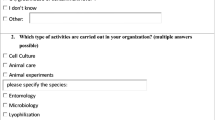Summary
The personnel in laboratories that utilize tissue and fluids from humans and other primates are at risk for infection with agents, including the viruses causing hepatitis, AIDS, and other infective agents such as mycobacteria tuberculosis. To minimize the chance of infection of laboratory personnel, carefully organized policies and procedures to minimize exposure to infective agents must be established in research laboratories. We outline some of the approaches of hospital clinical laboratories which have proved most effective in minimizing transmission of infections from samples to laboratory personnel. Also, we discuss simple considerations important in the use and in the selection of safety equipment. These guidelines and references to other safety information are provided to aid research laboratories in establishing safety procedures that will minimize chances of personnel contamination with infective agents from research samples.
Similar content being viewed by others
References
Centers for Disease Control. Acquired immune deficiency syndrome (AIDS): precautions for clinical and laboratory staffs. Morbidity and Mortality Weekly Report (MMWR) 31:577–580; 1982.
Centers for Disease Control. Acquired immunodeficiency syndrome (AIDS): precautions for health-care workers and allied professionals. MMWR 32:450–451; 1983.
Centers for Disease Control. Recommendations for preventing possible transmission of human T-lymphotropic virus type III/lymphadenopathy-associated virus from tears. MMWR 34:533–534; 1985.
Centers for Disease Control. Recommendations for preventing transmission of infection with HTLV-III/LAV in the workplace. MMWR 34:682–695; 1985.
Centers for Disease Control. AIDS recommendations and guidelines. November 1982–November 1986.
Centers for Disease Control. Revision of the CDC surveillance case definition for acquired immunodeficiency syndrome. MMWR Supplement 1S, 36:1s-15s; 1987.
Centers for Disease Control. Recommendations for prevention of HIV transmission in health-care settings. MMWR Supplement 2S, 36:1s-18s; 1987 Reprinted in Lab. Med. 19:88–95; 1988.
College of American Pathologists. Summary of recent information: acquired immunodeficiency syndrome. July; 1983.
Conte, J. E., Jr.; Hadley, W. K.; Sande, M., et al. Infection-control guidelines for patients with the acquired immunodeficiency syndrome (AIDS). N. Engl. J. Med. 309:740–744; 1983.
Favero, M. S. Biological hazards in the laboratory. Lab. Med. 18:665–670; 1987.
Gerberding, J. L.; Bryant-LeBlanc, C. E.; Nelson, K., et al. Risk of transmitting the human immunodeficiency virus, cytomegalovirus, and hepatitic B virus to health care workers exposed to patients with AIDS and AIDS-related conditions. J. Infect. Dis. 156:1–8; 1987.
Goldie, D. J.; McConnell, A A.; Cooke, P. R. Heat treatment of whole blood and serum before chemical analysis. Lancet 1161:May; 1985.
Haber, S. L. Part 1: What every laboratorian should know about AIDS. Med. Lab. Observer November: 32–38; 1985.
Haber, S. L. Part 2: What every laboratorian should know about AIDS. Med. Lab. Observer December:55–59; 1985.
HHS Publication No. (CDC) 84–8395. Biosafety in microbiological and biomedical laboratories. 1st ed. March; 1984.
Maas, A. E. AIDS autopsy precautions. Pathologist November:20–21; 1985.
MacArthur, S.; Schneiderman, H. Infection control and the autopsy of persons with human immunodeficiency virus. Am. J. Infect. Control 15:172–177; 1987.
Miller, B. M., ed. Laboratory safety: principles and practices. Washington, D.C.: American Society for Microbiology; 1986.
National Committee for Clinical Laboratory Standards (NCCLS) Proposed Guidelines. Protection of laboratory workers from infectious disease transmitted by blood and tissue. NCCLS Document M29-P, vol. 7 no. 9; 1987.
Pattison, C. P.; Boyer, K. M.; Maynard, J. E., et al. Epidemic hepatitis in a clinical laboratory: possible association with computer card handling. JAMA 230:854–857; 1970.
Spire, B.; Dormont, D.; Barre-Sinoussi, F., et al. Inactivation of lymphadenopathy-associated virus by heat, gamma rays, and ultraviolet light. Lancet. January:188–189; 1985.
Valenti, W. M. AIDS and the lab: infection control guidelines. Med. Lab. Observer February:53–56; 1986.
Wofsy, C.; Kaplan, L.; Volberding, P. Clinical and laboratory features of HIV infection. Abbott Park, IL: Abbott Diagnostics Educational Services. September; 1987.
Author information
Authors and Affiliations
Rights and permissions
About this article
Cite this article
Grizzle, W.E., Polt, S.S. Guidelines to avoid personnel contamination by infective agents in research laboratories that use human tissues. Journal of Tissue Culture Methods 11, 191–199 (1988). https://doi.org/10.1007/BF01407313
Issue Date:
DOI: https://doi.org/10.1007/BF01407313




